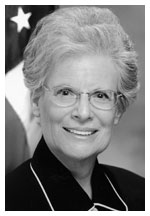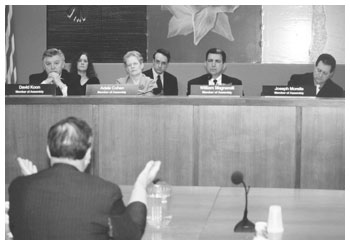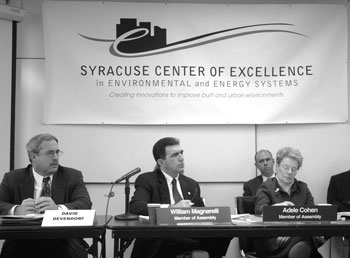|
Strategy for Commercialization
On February 27, 2006, Assemblywoman Adele Cohen, chairwoman of the Commission
on Science and Technology, held a hearing in Albany, New York, on The Role of New
York State in Commercializing Research & Development Innovations. The hearing
was co-sponsored by Assemblymembers Joseph D. Morelle, chairman of the Subcommittee
on Manufacturing, and William B. Magnarelli, chairman of the Task Force on University-Industry
Cooperation. The purpose of the hearing was to identify and articulate a strategy for assisting the
commercialization of innovations resulting from State-sponsored research and development
(R&D) conducted at research institutions throughout New York.
Testimony was received from over 40 witnesses and there were many interesting and insightful
observations and recommendations focusing on funding, structure, space, business assistance,
entrepreneurial programs, and workforce development.
In recent years, New York State has invested well over one billion dollars in university-based
R&D at institutions throughout New York. However, concern was expressed by many
witnesses that the State does not invest enough in the early, start-up stage, where these funds
are most deficient, and that the smallest businesses, those with the least amount of funding
available, are least able to take advantage of federal investments which require a dollar-for-dollar
match. Overall, witnesses urged the State to provide seed or gap funding for early stage
development, tax credits for investors who take the risk of investing in this early, unproven stage,
and to utilize the State Retirement Fund in a more direct way for this crucial period of business
development.
Another concern was the absence of a coherent structure for commercialization assistance – that
is, no single process or entry point for services, and no consistent, uniform set of policies and
directives for the lab-to-market continuum. Recommendations included establishing an Office of
Technology Commercialization, and a one-stop approach.
The crucial need for commercial space was also addressed, as was the importance of business and
entrepreneurial assistance. Several witnesses recommended using the regional Small Business
Development Centers and university schools of management and business to provide services, and
strengthening the entrepreneurial climate in the State through entrepreneurial boot camps, business
plan contests, coaching and mentoring.
Finally, the crucial area of workforce development was discussed by most, if not all, of the witnesses.
Assemblymembers heard, for example, that doctorates in science and engineering have declined since
1988, and that the U.S. produces approximately 70,000 engineers per year compared to India and China,
which produce 10 times that number. In addition, less than 6% of 24 year olds in this country earned a
B.S. in science, ranking this country 25th in the world. In addition to enhancing science, math and
engineering education, it was strongly recommended that education include relevant
commercialization-related programs – especially in regulatory affairs, quality assurance and control,
and good laboratory practices. Further suggestions included creating forgivable student loans for those
who agree to stay and work in the State for a prescribed period and funding targeted workforce training in
cooperation with regional initiatives, including university R&D efforts, and growth businesses; and
investing in education and retraining with particular emphasis on emerging science and engineering fields.
Reinforced by the hearing testimony, the Commission remains committed to supporting existing and future
legislative and programmatic efforts regarding commercialization in New York State.
The following bills are part of these initiatives:
-
A. 3443 (Schimminger) would re-establish the State
SBIR program and gap funding. Passed Assembly.
-
A. 3791A (Morelle) would create the Manufacturing
Technology Act to provide grant assistance for retraining and for upgrading existing
factories. Passed Assembly.
-
A. 4105 (Espaillat) would expand State investment in
affordable, appropriately equipped commercial space in which companies spinning out
of New York’s academic research institutions can set down roots and grow.
Passed Assembly.
-
A. 6431A (Magnarelli) would create a statewide grants
program to assist small businesses in commercializing intellectual property purchased
or licensed from a New York State research institution. Passed Assembly.
-
A. 6633B (Magnarelli) would create the Research and
Development Fiscal Accountability Act of 2006 to institute reporting requirements for
State-supported science and technology programs to measure their viability in advancing
the economic development goals of the State. Passed Assembly.
-
A. 6758A (Cohen) would provide small businesses with
grants of up to $100,000 to commercialize energy and environmental technology innovations
and ideas in-state to stimulate economic development. Passed Assembly.
For more information on the hearing, contact the Commission at (518) 455-5081.
|



